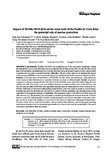Mostrar el registro sencillo del ítem
Impact of El Niño 2015-2016 on the coral reefs of the Pacific of Costa Rica: the potential role of marine protection
| dc.creator | Alvarado Barrientos, Juan José | |
| dc.creator | Sánchez Noguera, Celeste | |
| dc.creator | Arias Godínez, Gustavo | |
| dc.creator | Araya Arce, Tatiana | |
| dc.creator | Fernández García, Cindy | |
| dc.creator | Guzmán Mora, Ana Gloria | |
| dc.date.accessioned | 2021-04-12T17:37:55Z | |
| dc.date.available | 2021-04-12T17:37:55Z | |
| dc.date.issued | 2020 | |
| dc.identifier.citation | https://revistas.ucr.ac.cr/index.php/rbt/article/view/41190 | |
| dc.identifier.issn | 0034-7744 | |
| dc.identifier.uri | https://hdl.handle.net/10669/83212 | |
| dc.description.abstract | Introduction: El Niño 2015-2016 was considered one of the most severe worldwide, causing the third global event of coral bleaching. Previous high-intensity El Niño events (1982-83 and 1997-98) caused high coral mortalities and deterioration of coral reef structures along the Eastern Tropical Pacific, affecting both ecosystem and associated economical activities. Objective: The aim of this study was to determine the impact of the most recent El Niño event on coral reefs from Cocos Island and the Pacific coast of southern Costa Rica. Methods: Coral reefs were surveyed before (2013-2014) and after (2016) the disturbance, using underwater visual censuses within belt transects, to quantify the bottom coverage at different depths. Results: In general, average live coral cover decreased 50% after the 2015-2016 El Niño event, with Golfo Dulce being the most affected area with 75% of live coral cover decline. However, in certain localities such as Isla del Coco and Isla del Caño, the effects of El Niño were apparently minimal, since no substantial loss of live coral cover was detected. Differences in the level of deterioration found between coral reefs could be related to several factors, including the age of the protected area, the distance to centers of human population, and the effectiveness in the application of management strategies. Conclusions: The synergistic impact of the 2015-16 El Niño event and other stressors (e.g. illegal fishing and unregulated coastal human development) increased the levels of disturbance on coral reefs, threatening their structure and functioning. It is necessary to strengthen conservation strategies in order to improve the resilience of coral reefs to the impact of natural and anthropogenic disturbances. Concrete actions such as coral reef restoration, marine environmental education, and marine spatial planning must become important tools to maintain the good health of coral reefs and ensure the sustainability of the goods and services provided by these ecosystems. | es_ES |
| dc.language.iso | eng | es_ES |
| dc.source | Revista de Biología Tropical Vol. 68(Suppl. 1): | es_ES |
| dc.subject | coral bleaching | es_ES |
| dc.subject | crustose coralline algae | es_ES |
| dc.subject | conservation strategies | es_ES |
| dc.subject | marine protected areas | es_ES |
| dc.title | Impact of El Niño 2015-2016 on the coral reefs of the Pacific of Costa Rica: the potential role of marine protection | es_ES |
| dc.title.alternative | Impacto del fenómeno El Niño 2015-2016 en arrecifes coralinos del Pacífico de Costa Rica | es_ES |
| dc.type | artículo original | |
| dc.identifier.doi | 10.15517/RBT.V68IS1.41190 | |
| dc.description.procedence | UCR::Vicerrectoría de Investigación::Unidades de Investigación::Ciencias Básicas::Centro de Investigación en Ciencias del Mar y Limnología (CIMAR) | es_ES |


